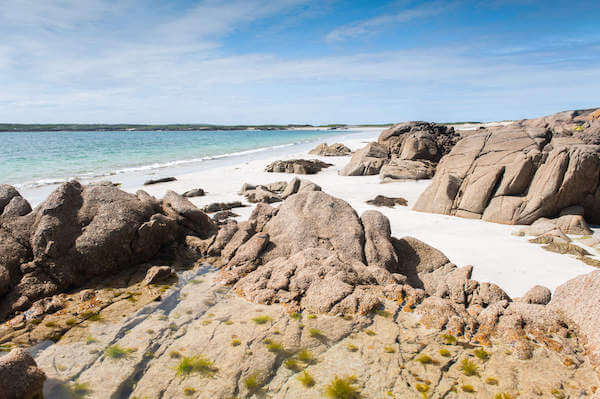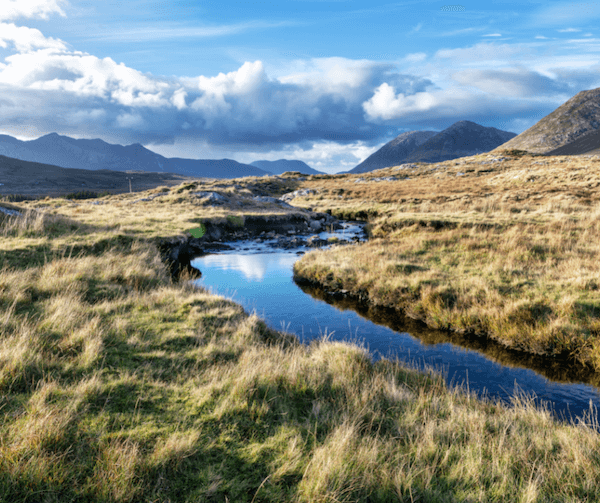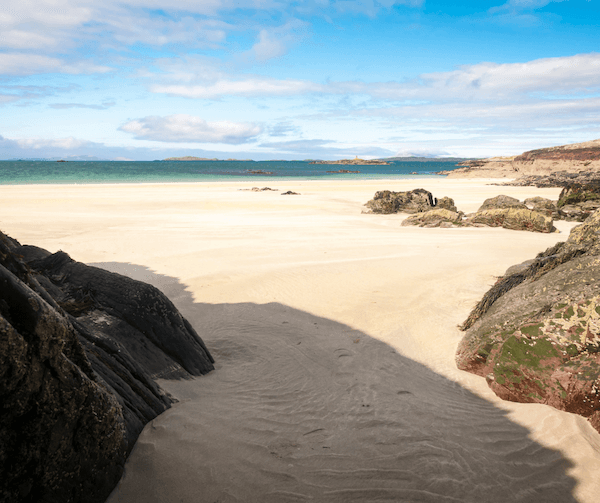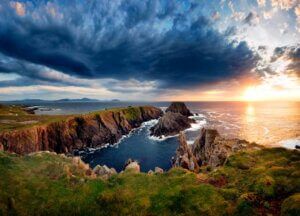Many of the popular tour companies include Connemara National Park and the surrounding area on their travel itineraries. This rugged region of County Galway is a popular stop for sure, but if you’re interested in discovering the area by yourself, especially if you're already exploring the Wild Atlantic Way, here are 7 hidden attractions in Connemara that are worth exploring.
 This post and page contain affiliate links and I may earn compensation when you click on the links at no additional cost to you.
This post and page contain affiliate links and I may earn compensation when you click on the links at no additional cost to you.
The region has a strong association with traditional Irish culture and is the largest Irish-speaking part of Ireland.
Long before it made it to the popular guidebooks, however, Connemara was admired by many, including some of Ireland’s more well-known writers.
Oscar Wilde described it as a “wild mountainous country,” while WB Yeats and John Millington Synge looked to the remote landscape as a place where life could be lived more simply.
To see these 7 hidden attractions in Connemara that are listed below, you’ll need a rental car since they are not easily accessed by public transportation.
There are several car rental companies in Ireland to choose from, but if you want to do some comparison shopping, I recommend Discover Cars.
Cleggan Village and Cleggan Head
This small fishing village is in an area of Connemara that doesn’t get as many visitors as the more well-known towns like Clifden, a mere 10 km (7 miles) away, but it’s totally worth a stop if you’re in the region.

One of the focal points in the village is the bridge built by the Scottish architect Alexander Nimmo.
Nimmo moved to Ireland in 1810 to investigate the drainage and cultivation of Irish bogs.
He fell in love with the Connemara region and stayed there for many years, eventually building many of the piers around the Galway coastline, as well as developing the carriage road from Oughterard to Clifden.
By clicking on the Amazon link below, I may earn a small commission from the Amazon Associates Program. However, you will not incur any additional costs by doing so.
Never lose track of your luggage with Apple Air Tag
Hike Cleggan Head
Several beaches dot the coastline here, but to get a sense of the sheer beauty of the area, you should consider a hike to Cleggan Head, which lies on the northern end of Cleggan Bay.
Cleggan Head is on private land. However, visitors are allowed to walk on a track that runs between the owner’s private farm buildings and those that form part of Cleggan Farm Cottages.

Dogs are not allowed, even those on a leash, since the property is a working sheep farm.
On your way to the top of Cleggan Head, there’s plenty to see and experience, including a variety of plant and animal life, as well as a Neolithic wedge tomb.
From the top, you’ll get extraordinary views of Inisturk and Clare Islands to the north, as well as Achill Island, the Mweelrea and Partry Mountains, and of course Croagh Patrick.

A secluded cove sheltering a small beach adds to the beauty of the area.
See Ireland with Aer Lingus – Discover Special Offers on the Aer Lingus Vacation Store
Knockbrack Court Tomb
About 1.6 km (0.9 miles) from Cleggan, look for the Knockbrack Court Tomb located in an area overlooking Sallerna Beach on the Aughrus Peninsula.

Archaeologists say that this Megalithic chamber is unusually narrow for a court tomb at only 0.8 meters (2.62 feet) wide.
The slab is also known as “Labbadermot” or “Dermot’s Bed,” referring to the legend of Diarmuid and Grainne, the lovers who were chased around Ireland by Grainne’s betrothed, Fenian chieftain Finn McCool.
To protect them from their enemies, Diarmuid built 365 different “beds” like the capstone on this one, which would have been invisible to everyone except them.
Dog’s Bay Beach
This is one of Ireland's finest beaches, although it doesn't always get top billing.

Dog’s Bay Beach is about two miles outside Roundstone and located on the road to Clifden, Connemara’s largest town.
The sand here is made up of seashell fragments, giving it a pure white color.
Since it is sheltered from currents, the water here is calm and crystal clear.
The area around here is known internationally for its rare ecological, geological, and archaeological features.
The grasslands are also rare and are native to the west coast of Ireland and Scotland.

Gurteen Beach is equally beautiful and is situated beside it. All that separates them is a wild headland that juts out into the Atlantic Ocean.
The Moyrus Loop (Lúibín Mhaírois)
This looped walk, a mix of beach and boreen, is another hidden attraction in Connemara to add to your itinerary.
Begin at the Moyrus cemetery, the site of a medieval church, and make your way along the coast, ending in the townland of Halfmace.
Near the cemetery, you’ll find the remains of a church set up in 1855 by a Protestant Christian group called the Irish Missions.

Some of the highlights of the walk include the rocky shoreline that leads to An Trá Mhór (when translated, means “Large Beach”), a long, sheltered beach that is perfect for swimming.
An old wartime lookout shelter on a nearby headland provides great views of St. Macdara’s Island, which houses an ancient oratory and is dedicated to the patron saint of fishermen and sailors.
The Mace Head Atmospheric Research Station is also close by.
It is one of the longest-running mercury recording stations in the world and gathers vital information used to study the atmosphere.

All along this beautiful walk, you can see the Twelve Bens Mountain range and many of the smaller islands that exist in the region.
Get Wifi While Traveling Around Ireland – take 10% off by using code IOB2024
Maumeen Mountain Pass and Shrine
A half-hour drive north will take you to the Maumeen Mountain Pass.
Be sure to wear your hiking boots on this 2 to 4-hour hike, an ancient trail that leads to a mountainous pilgrimage site dedicated to Saint Patrick.
At the end of the 4-km hike (2.5 miles) walk you’ll reach the Maumeen Pass located in Connemara’s Maumturk Mountains, with epic views of the surrounding lakes and bogland.

While the site is dedicated to Patrick, it was also an important pilgrimage spot in pre-Christian Ireland, where the god Lugh was idolized.

The mountain pass is the second highest in Ireland after the Connor Pass in County Kerry’s Dingle Peninsula.
At the top is a statue of Patrick with a ram in his hand, a reference to the legend that claims he sank a ram in a nearby lake.
A small chapel called Cillín Phádraig is located behind the statue, as well as a holy well.

During the 17th and 18th centuries when Irish Catholics were prevented from practicing their faith, mass was said on a nearby rock that today is known as “St. Patrick’s bed.”
Each year on the last Sunday in July, a pilgrimage takes place where mass is said in the Irish language.
Foher Famine Village
Away from the coast in North Connemara where the counties of Galway and Mayo meet, you’ll find the last remaining famine villages in Ireland.
The original potato ridges where the local people eked out a living from a crop that would fail miserably in the middle of the 19th century are also evident.

The Foher Famine Village is located close to Killary Fjord, one of three glacial fjords on the island of Ireland.
Nearby is an unfinished “famine relief road” snaking its way up and over the nearby mountainside.
It is one of several public works projects that the Irish were expected to work on in return for meager rations and a small allowance from the British government.

Many of the residents of the Foher famine village died, with many more emigrating.
Set in a beautiful region of Connemara, with fabulous mountain vistas, this out-of-the-way hidden attraction is a stark reminder of Ireland’s dark past.
Glassilaun Beach
The water is fresh and clear at the horseshoe-shaped Glassilaun Beach, which is located between Renvyle and Killary Bay.

It also has an impressive mountain backdrop, which makes this a must-see attraction on your tour of Connemara’s hidden gems.
The beach is popular for swimming, snorkeling, and walking.
Here is a Google map outlining the locations mentioned above and how to get to them.
Have you explored Connemara? Let me know in the comments below.
Read More: Dublin to Galway in Three Days: 8 Attractions You'll Love



